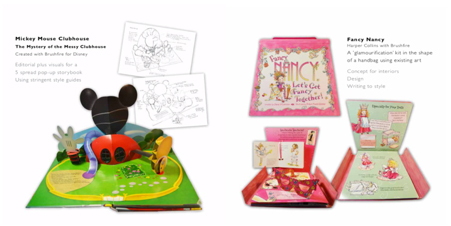Interview
Interview with sally symes author and book designer about my ISTD final outcome.
A little about sally… Firstly, you may know that I’m now an editor and author, so although I still design, I am very much involved in the creating and writing of the books. I specialise in pre-school novelty picture books - so that’s about 1-5 years.
What are your favourite features of the book?
I like its simplicity and the child-friendly images that they can easily identify with. It is very elegantly designed. The fonts you have chosen for each food are very apt - I particularly like the noodle one!
What would you change about the book?
If you are definitely aiming this at 0-5 year olds, I would think about making it a little bit more interactive. Maybe make it into a flap book with a guessing element involved? I would think about making this into an adult gift book… it is very elegant.
How did you become a book designer?
I have always been passionate about illustrated children’s books. My first job was with an independent and very small group called, Design Eye who specialised in non-fiction kit books for various crafts and hobbies. I styled and project-managed their “Funstation” range for children on varied subjects such as science, nature and arts and crafts. My job included commissioning and working with writers, photographers, illustrators as well as sourcing components from the Far East.
What influences your practice the most?
I like to be original. So I try to come up with an idea that is different and that children will have fun with (and hopefully learn from too). If it’s a novelty book, I try to make sure that it isn’t too expensive to make and choose an illustrator who is appealing to all markets both in the UK and abroad.
What processes do you go through when making a book?
I have a lot of ideas and write them down, even if that’s only a line or two. More often than not they aren’t any good, but occasionally, I have a decent one! I collaborate a lot with illustrators, so with the latest books I have done, I took the idea to one of the illustrators and we threw it around. I came away with something quite different from where we started! I then wrote the text and drew the idea very roughly up (as 2 books) to see if it worked, then he did colour roughs for me which I set up in InDesign and then played with a few fonts. I then made dummies of the 2 books which we looked at together - always essential so you can get a ‘feel’ for how the book works physically. We made a couple of changes - to the covers especially - which we didn’t agree on! I took them to our publisher who will probably re-design them slightly according to their house-style. (Children’s publishers sometimes have certain fonts that only they use).
Is book designing something you have always wanted to do?
I really enjoy the process of designing and putting a book together, especially my own, but it’s never been my main joy. I think I always wanted to be the creator - I love coming up with the ideas and I’ve now become an author.
What are the biggest challenges you face when book designing?
I think the hardest thing is having your designs changed. Designing books (covers especially) is very collaborative. You have to answer to a lot of people, editors, art directors and sales people. Their priorities aren’t necessarily the same as your own.
What is your favourite book?
Hmmm, that’s tricky. One of my favourite books is, “Don’t Put Your Finger in the Jelly, Nelly” by Nick Sharratt. I used to read it to my children when they were small, and they’d take it in turns to out their fingers through the holes in the pages. The words have a wonderful rhythm and the pictures are divine. It’s very funny and has a fabulous ending.
What is your favourite audience to design for?
You may have guessed that - children aged 0 - 5 years!
What is the best advice you could give me when making a book in the future?
Think very hard about the subject matter and who it’s for. Go to bookshops and see what else is available and make your idea different and better. Be daring with your design - have fun playing with the elements on the page and don’t be too neat at the start of the process… in fact, keep away from the screen to start with! I sometimes draw rough page options just to see how it might look then scan it in to play about with. You’ll end up with a more original book that way. Listen to advice from colleagues but stick to your guns if you really believe in something.
Books and cover designs by Sally that influenced my practice.
Books by sally which I’ve had since I was little, it’s very interactive and was one of my favourite books when I was little, and it made me laugh a lot. This is why I picked sally to interview as her books are very successful and are aimed at the same audience as mine.


